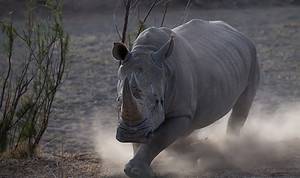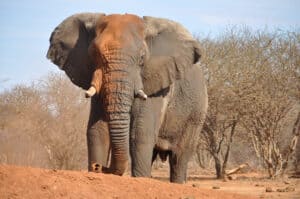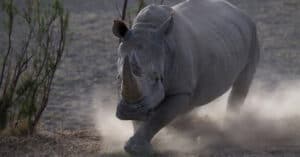Unlike the rhinoceros we see today, the Woolly Rhinoceros had thick and shaggy hair covering them. This was probably due to the fact that they lived in extremely cold environments — though some of them lived in grasslands too. Like modern rhinos, they had horns that stuck out in front of their heads.
The Woolly Rhinoceros, or the Coelodonta antiquitatis, was a large species of the rhinoceros. It lived in Eurasia during the Pleistocene epoch. This was about 1.8 million years to 10,000 years ago, at the end of the last Ice Age. The earliest known Woolly Rhinoceros fossil was found in the Tibetan area. The fossil was believed to be at least 3.6 million years old.
Lately, experts clarified that this species became extinct because of climate change and not hunting as originally thought. Their long, thick coats would have made it impossible for them to tolerate higher temperatures. As the ice-age receded, their habitat went with it. They might have been pushed to migrate from the Tibetan plateau to colder areas of the world.
| Habitat | Plains of Northern Eurasia |
| Historical epoch | Pleistocene to modern (3 million to 10,000 years ago) |
| Size and weight | About 11 feet long and 4,000 to 6,000 pounds |
| Diet | Grass |
| Distinguishing characteristics | Moderate size, two horns on head, shaggy fur |
Description and Size
The Woolly Rhinoceros is one of the Ice Age megafauna mammals memorialized in cave paintings. It is similar in appearance to the modern rhinoceros. It had a beefy body with short legs and had a front horn bigger than the back horn. The upward-curving horn was on the tip of its snout, while the smaller one was set nearer the eyes.
This animal used the horn for sexual displays. Male Woolly Rhinoceros had bigger horns, making them more attractive to females during mating season. The horns were also for practical reasons, like removing snow from the top of the soil to access the grass underneath. Fossils of the horns had abrasions on them, leading many to believe that these were used to shove away snow and other things.
However, these horns were merely projections. They were not actual horns, and they had no skeletal support. Rather, these horns were epidermal derivatives composed of the hair protein called keratin.
The hair of the Woolly Rhinoceros was made of two kinds. The undercoat was thin and dense, while the overcoat was long and rigid.
Fossils found of the Woolly Rhinoceros showed that it measured between three to 3.8 meters, or 10 to 12.5 feet, in length. They had a height of about two meters (6 feet) at the shoulder. The weight was an average of three tons.
The physical characteristics of the Woolly Rhinoceros gave them the adaptability needed to survive in their environment. Their stocky limbs and thick, shaggy fur were made for the cold climate and for traveling across the steep tundra.

©iStock.com/aleks1949
What Did Woolly Rhinoceros Eat?
The Woolly Rhinoceros was an herbivore. They are similar to the present-day rhinos. However, there are some controversies regarding their diet. Investigations revealed that they could both be grazing and browsing. Grazing means eating grass and other low vegetations, while browsing refers to eating leaves and woody twigs from trees and shrubs. It is believed that the Woolly Rhinoceros was particular to trees, moss, grasses, and bushes.
These assumptions were born out of several lines of evidence. However, more prevalent of this evidence was that the Woolly Rhinoceros was more into grazing than browsing. The biochemical investigation of the skull, mandible, and teeth of a Woolly Rhinoceros from Staffordshire showed the musculature and dental characteristics of an animal that fed by grazing.
Another piece of evidence is the enlargement of the animal’s temporalis and neck muscles. They used force to tug at grass from the ground.
Did they eat by themselves? Most likely, the Woolly Rhinoceros fed similarly to the modern rhinos. They can either be alone or with a group or family.
Habitat
The common belief is that the Woolly Rhinoceros lived in Eurasia, mainly in Ice Age landscapes. And while that is true, there are also pieces of evidence that show a different ancestral home. Discovering several fossils in the Tibetan Plateau meant that the Woolly Rhinoceros lived there more than one million years before the species migrated to northern Eurasia. The warming climate blocked the notion that most of the creatures that survived during the Ice Age thrived in the high Arctic.
A variety of fossils — a skull, jawbone, and neck vertebrae — were found at the foot of the Himalayas. The Tibetan Plateau is often called “the roof of the world” because it is the tallest and largest at 2.5 million square kilometers. It also has an average elevation of 14,800 feet. The fossils of the Woolly Rhinoceros were entombed there.
Using the age of the sediments that formed the fossil, researchers found the fossils to date back to some 3.7 million years. This proved the presence of this type of rhino in the Tibetan Plateau way before it was found in the arctic tundra of northeastern Siberia. The graveyard of this now-extinct megafauna in Siberia dates back to only 50,000 years compared to the 3.7-million-years-old fossils in the Himalayas.
There are also possibilities that the Woolly Rhinoceros might have reached France. People found charcoal drawings of the Woolly Rhinoceros on the limestone walls of Chauvet Cave in southern France.
Threats and Predators
Humans are the number one threat to the rhinos. Since this animal was an herbivore, it only fed on moss, trees, grass, and shrubs. While it was gigantic, there was no reason for smaller animals to fear them since they posed no real threat. It was widely believed that humans hunted the Woolly Rhinoceros, though there are other schools of thought regarding this.
Discoveries and Fossils
There are many fossil materials of the Woolly Rhinoceros. The reason for this is, like the Woolly Mammoth, the rhino had been found almost intact in permafrost. The most popular of these fossils is Sasha. A juvenile Woolly Rhinoceros, Sasha was discovered by a hunter in Siberia. Sasha is a well-preserved five-foot-long corpse covered in shaggy hair.
So intact is Sasha that scientists are trying to get a DNA sample from it. If they become successful, they can combine this with the genome from the Sumatran Rhino and officially reproduce a Woolly Rhinoceros.
Before this discovery, the Woolly Rhinoceros first appeared in fossils about 350,000 years ago. The fossils, either in ice or oil-saturated soils, were found in Asia and Europe. Apparently, the woolly rhinos never made it as far as North America. In Ukraine, they found a complete carcass of a female rhino. It was only lacking fur and the hooves.
Four Woolly Rhinoceros were also discovered in a quarry in Whitemoor Haye, Staffordshire. These fossils were about 30,000 to 50,000 years old. This 2002 discovery proved that the rhinos were herbivores since a well-preserved piece of grass was found stuck in one of the rhinos’ teeth.
Drawings of the Woolly Rhinoceros on the caves of southern France also proved that they once roamed the Earth. These drawings are at least 30,000 years old, experts said.

©Catmando/Shutterstock.com
Extinction
For years, humans were seen as the culprit for why the Woolly Rhinoceros became extinct. Many believed that when humans started occupying Siberia, it became impossible for the rhinos to co-exist since humans were hunting them. Humans and these rhinos overlapped for about 16,000 years. However, the latest evidence disproved this.
Upon analysis of the DNA samples, scientists concluded it was climate change that caused the Woolly Rhinoceros to die. The appearance of humans did not lead to a decline in the rhinos’ population. Instead, scientists found that the extinction started to happen 18,500 to 14,000 years ago when the world underwent rapid warming, called the Bølling–Allerød interstadial event.
This does not mean humans did not hunt the rhinos. It only meant they were not directly responsible for their extinction. Indirectly, humans may have been the reason for the warmer climate, which led to the rhinos’ demise.
Similar Animals to Woolly Rhinoceros
The Woolly Rhinoceros are similar to present-day rhinos.
- White Rhinos: Also called square-lipped rhinoceros, the white rhino is the largest extant species of rhinoceros. Its wide mouth is used for grazing. These are also the most social of all rhinos. However, like the western black rhino, white rhinos are extinct in the wild. There are only two female white rhinos, but they are under 24-hour security in Ol Pejeta Conservancy in Kenya. The last male white rhino died in 2018, which meant there was no way for the two remaining females to breed.
- Sumatran Rhinoceros: This is the most similar to the Woolly Rhinoceros since the Sumatran rhinos are also covered with hair. They are the smallest living rhinoceroses and the only Asian rhino with two horns. There are fewer than 80 Sumatran rhinos in the world. They are also currently extinct in the wild. The only Sumatran rhinos are in heavily protected areas. They are being guarded by Rhino Protection Units and Wildlife Protection Units.
Up Next:
- Discover the 3 Extinct Types of Rhinos
- Are Rhinos Extinct: The Conservation Status of Every Rhino Species
- This 3,000lb ‘Heavy Rhinocerous’ Roamed South America in Huge Numbers
The photo featured at the top of this post is © Daniel Eskridge/Shutterstock.com
FAQs (Frequently Asked Questions)
When was the Woolly Rhinoceros alive?
The Woolly Rhinoceros lived during the Pleistocene epoch to about 10,000 years ago. They inhabited the Tibetan Plateau and Eurasia.
How big was the Woolly Rhinoceros?
The Woolly Rhinoceros was about 11 feet long. They weighed as much as 6,000 pounds.
What did the Woolly Rhinoceros feed on?
All five species of rhinoceros are herbivores. The Woolly Rhinoceros ate only vegetation. They fed on grass, trees, and shrubs. Their horns were used to shovel snow out of the way so that they could graze the grass underneath the ice.
What are the distinguishing features of Woolly Rhinoceros?
The Woolly Rhinoceros had two horns on the head, making them distinct. However, it was its shaggy fur that made it a standout.
Thank you for reading! Have some feedback for us? Contact the AZ Animals editorial team.







